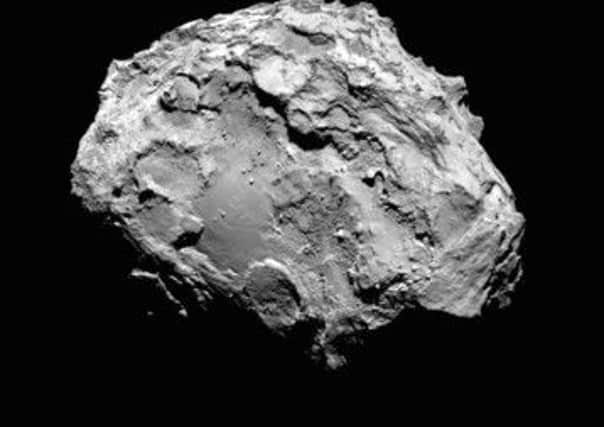Comment: Does Rosetta hold key to mystery of life?


Many of the bones are inscribed with questions posed to ancestral spirits about solar and lunar eclipses, planets and stars, which make them useful sources of evidence, not only for the understanding of ancient Chinese history, but also for astronomers. The oracle bones show that, for millennia, human beings have looked up at the sky and tried to make sense of the universe.
Comets were often interpreted as a bad omen. They look a bit like a ball of fire with a long tail, and they appear in the sky as if from nowhere, so it’s not hard to see why: what sane person wouldn’t be frightened by or feel in awe of such a spectacle?
Advertisement
Hide AdAdvertisement
Hide AdComets were taken to signal impending catastrophes, and known as “the terror of kings” in the Middle Ages. One is embroidered on the Bayeux Tapestry, the cloth made in the 11th century which celebrates the conquest of England by William, Duke of Normandy. Human figures are shown nervously pointing at a ball of fire up above them.
We now know that this comet on the tapestry is one in particular – Halley’s comet – which was named after the English astronomer Edmond Halley. It was given his name after he made a major scientific breakthrough in 1705. Halley argued that reports of a comet approaching the Earth on three different occasions were in fact the same comet. He discovered that Halley’s comet was a periodic comet: it orbits the sun and returns to the Earth’s vicinity about every 76 years.
Halley’s comet is due next in around 2061 and was last here in 1986. Most of us, then, have seen or will have a chance to see a comet that William Duke of Normandy may well have seen himself. Indeed, across history, the sight of this one comet has fired the imaginations of people all over the world. It turns out that records of Halley’s comet, which was then unnamed, of course, were made by the ancient Chinese chroniclers, as well as by the Babylonians.
As each century has passed we have learnt more about our universe. We now know that comets are the oldest bodies in the solar system. We now know that they are not balls of fire, but remnants from the formation of the planets and largely made of ice: carbon dioxide ice, methane ice, and water ice, with a sprinkling of dust and small stony particles. They are, basically, very large dirty snowballs. They have regular orbits, which brings them close to earth, which is why we get to see them.
Comets signal nothing in that they do not herald an impending catastrophe, even though some remain a focus for certain conspiracy theorists. However, there remains a great deal about them that we do not know or understand.
In the long history of comet watching, this week saw an exciting development, one that we should cheer. For the past decade, the Rosetta spacecraft, launched and run by the European Space Agency, has chased a comet known as 67P/Churyumov-Gerasimenko. It doesn’t have the catchiest of names, so it is sometimes referred to as the rubber duck comet, because that’s what it looks like, albeit a very big rubber duck as it is larger than Mount Fuji.
So far the Rosetta spacecraft has followed 67P/Churyumov-Gerasimenko across four billion miles of deep space, on a complex and delicate trip that included initially looping around the sun five times to build up speed, before executing a number of manoeuvres over the past few months to slow down.
Rosetta has just pulled up alongside 67P/Churyumov-Gerasimenko. Rosetta cannot land on the comet, it has to follow it, and is currently doing so from about 62 miles above it. It is the first probe ever to orbit a comet.
Advertisement
Hide AdAdvertisement
Hide AdIn November, if all goes well, the spacecraft will drop on to the surface a lander which will drill into the comet to take samples and capture images – another space history first. The lander will be dropped as the comet passes closer to the sun, in order to monitor how the heat from the sun affects the ice on the comet’s surface.
Hopes for the mission are high. The composition of comets reflects the composition of the pre-solar nebula – out of which the Sun and the planets formed – over 4.6 billion years ago. Whereas planets have gone through chemical transformations, comets have remained pretty much unchanged. This means they can help us to understand the origin and evolution of the solar system and life on Earth.
There is already evidence that comets played a role in the forming of the planets – they may have brought the water in our oceans. The findings from this programme will shed light on how the ancient ice balls formed thousands of years ago and their role in moving the building blocks of life around the early solar system.
As Mark McCaughrean, senior scientific adviser with the ESA’s Directorate of Science and Robotic Exploration, explained during a webcast this week, the Rosetta mission will help us answer some big questions.
He said: “Where do we come from? Where does the solar system we live in come from? How was it put together? How was it assembled? How did the planets get built up individually, and how did water get to this planet that we live on?”
This is no small matter: it could be a giant leap for mankind. The spacecraft is named after the famous Rosetta Stone – the block of black granite that was the key to unlocking the civilisation of ancient Egypt. The Rosetta mission could well unravel the mysteries of our universe.
I bet that the Chinese scribe who documented his sighting of a comet on an oracle bone thousands of years ago is looking down on us with approval.